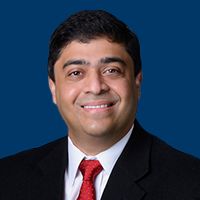Article
Sarcoma Experts Elucidate on Combination Chemotherapy Regimens
Author(s):
In a special episode of OncLive® On Air, Shiraj Sen, MD, PhD, and Roman Groisberg, MD, highlight research evaluating combination chemotherapy regimens in the evolving sarcoma treatment paradigm.
Shiraj Sen, MD, PhD

Emerging chemotherapy combinations have demonstrated encouraging safety and efficacy in patients with soft tissue sarcoma; however, certain subtypes respond differently than others to this approach, underscoring a great need for further research to optimize strategies and to explore new therapeutic avenues.
In a special episode of OncLive® On Air, Shiraj Sen, MD, PhD, associate director of Drug Development at Sarah Cannon Research Institute, and Roman Groisberg, MD, a medical oncologist at Rutgers Cancer Institute, highlighted research evaluating combination chemotherapy regimens in the evolving sarcoma treatment paradigm.
Perioperative Gemcitabine/Docetaxel Versus Adriamycin/Ifosfamide in High-Grade Disease
Although toxicities were modest with the combination of gemcitabine and docetaxel, noninferiority compared with doxorubicin plus ifosfamide could not be confirmed in patients with high-grade soft tissue sarcomas, according to results from a phase 2/3 study (UMIN000013175) presented during the 2020 ASCO Virtual Scientific Program.1
In the analysis, investigators sought to confirm the noninferiority of perioperative chemotherapy comprised of gemcitabine plus docetaxel versus adriamycin plus ifosfamide in patients with high-risk soft tissue sarcoma with operable, French Federation of Cancer Centers Sarcoma Group grade 2 or 3 disease or first local recurrent tumor in the extremities or trunk.
“To highlight a nuance of this study, there were more grade 2 tumors in the doxorubicin plus ifosfamide arm,” said Sen. “We know that, above all else, grade is the most important prognostic factor when it comes to sarcoma; this may have thrown off the final outcome.”
A total of 143 patients were randomized 1:1 to receive a daily 30 mg/m2 dose of adriamycin on days 1 and 2 g/m2 of daily ifosfamide on days 1 to 5 every 3 weeks (n = 70) or 900 mg/m2 of daily gemcitabine on days 1 and 8 plus 70 mg/m2 of docetaxel on day 8 every 3 weeks (n = 73).
The primary end point of the phase 2 portion of the trial was proportion of completion of perioperative chemotherapy without disease progression and overall survival (OS) in the phase 3 portion. Key secondary end points included progression-free survival (PFS), response rate to preoperative chemotherapy, disease control rate (DCR) in the extremities and trunks, proportion of limb preservation in the extremities, and adverse effects (AEs) in the form of postoperative complications.
Results showed that 72.6% (95% CI, 60.9%-82.4%) of patients who received gemcitabine/docetaxel completed preoperative chemotherapy without disease progression versus 77.1% (95% CI, 65.6%-86.3%) of those on the adriamycin/ifosfamide arm (P = .57). In the experimental arm, no patients achieved a complete response (CR), while 3 patients experienced a partial response (PR); no patients experienced a CR and 1 patient achieved PR on the control arm.
Moreover, the 3-year PFS rate was 59.1% with gemcitabine/docetaxel (95% CI, 45.3%-70.5%) versus 79.1% with adriamycin/ifosfamide (95% CI, 65.5%-87.8%; hazard ratio [HR], 2.32; 95% CI, 1.22-4.39; two-sided, P = .008). The median PFS in the experimental and control arms were 4.4 years (95% CI, 2.3–not reached [NR]) versus NR (95% CI, 4.1-NR).
The 3-year OS was 79.2% (95% CI, 64.0%-88.5%) on the gemcitabine/docetaxel arm versus 91.4% (95% CI, 78.1%-96.7%) on the adriamycin/ifosfamide arm (HR, 2.55; 95% CI, 0.80-8.14; one-sided, P = .78). Because the point estimate of the HR was above the prespecified noninferiority margin of 1.61, the Data Monitoring and Safety Monitoring and Safety Committee of the Japan Clinical Oncology Group recommended early termination of the study.
With regard to safety, AEs that were grade 3 or higher with preoperative chemotherapy included leukocytes (68.5% in the experimental arm vs 87.0% in the control arm), neutrophils (79.5% vs 88.4%, respectively), hemoglobin (5.5% vs 49.3%), platelets (5.5% vs 10.1%), and febrile neutropenia (17.8% vs 36.2%). For postoperative treatment, the rates of grade 3 or higher AEs included leukocytes (66.7% vs 84.9%), neutrophils (73.3% vs 81.1%), hemoglobin (0% vs 13.2%), platelets (4.4% vs 43.4%), and febrile neutropenia (4.4% vs 13.2%).
“I believe this was a very important study to conduct and I commend the authors. Many believed that there would be signs of noninferiority,” Groisberg added. “These perioperative studies can be very challenging, especially with all of the variables involved. Most importantly, it demonstrated that gemcitabine plus docetaxel is not noninferior to adriamycin plus ifosfamide.”
Doxorubicin/Trabectedin in Metastatic Uterine and Soft Tissue Leiomyosarcoma
Frontline trabectedin plus doxorubicin showcased encouraging efficacy in patients with metastatic/advanced uterine and soft tissue leiomyosarcoma, according to the final results from the phase 2 LMS-02 study (NCT02131480).2
After an encouraging overall response rate (ORR) was reported in 2015, along with manageable toxicities, investigators sought updated PFS and OS results in patients with metastatic or unresectable uterine and soft tissue leiomyosarcoma who had no prior lines of chemotherapy.
In the single-arm, multicenter phase 2 study, 108 patients were stratified based on primary tumor location and received 60 mg/m2 of doxorubicin every 3 weeks plus 1.1 mg/m2 of trabectedin as a 3-hour infusion on day 1 and pegfilgrastim on day 2, repeated every 3 weeks for up to 6 treatment cycles. The primary end point of the trial was DCR, while key secondary end points included duration of response, PFS at 12 weeks, OS, and toxicity.
“There are definite pros to conducting these single-arm, phase 2 studies. This trial really assessed patients with leiomyosarcoma and stratified by location: uterine or soft tissue, said Groisberg. “Ultimately, this helps us better understand how different subtypes are affected, rather than generalizing sarcoma as a whole.”
Previous results from the trial showed that the combination elicited an ORR of 59.6% in the uterine leiomyosarcoma group with a DCR of 87.2%; the ORR with the regimen was 39.3% in the soft tissue leiomyosarcoma group with a DCR of 91.8%.3
Final results showed an overall median PFS of 10.1 months (95% CI, 8.5-12.6). The median PFS was 8.3 months (95% CI, 7.4-10.3) in the uterine group and 12.9 month (95% CI, 9.2-14.1) in the soft tissue group. The overall median OS was 34.4 months (95% CI, 26.9-42.7). The median OS in the uterine group was 27.5 months (95% CI, 17.9-38.2) and 38.7 months (95% CI, 31.0-52.9) in the soft tissue group.
Investigators also analyzed the impact of surgery on PFS and OS. Without surgery, the PFS was 8.8 months (95% CI, 8.0-10.8) versus 18.2 months (95% CI, 9.5-54.5) with surgery. Without surgery, the OS was 31.6 months (95% CI, 23.9-35.4) versus NR with surgery.
When broken down by subgroup, the median PFS in the uterine group was 8.0 months without surgery versus 12.9 months with surgery. At 2 years, the median PFS rate was 68.4% without surgery versus 87.5% with surgery. The median PFS in the soft tissue group was 10.6 months without surgery versus 24.8 months with surgery. The median PFS rate at 2 years was 87.8% without surgery versus 100% with surgery.
In the uterine group, the median OS was 26.6 months without surgery versus NR with surgery. The 2-year OS rates were 55.3% versus 75.0% without surgery and with surgery, respectively. In the soft tissue group, the median OS was 34.8 months without surgery versus NR with surgery. The 2-year OS rates were 65.3% versus 100%, respectively.
“This study has the potential to be practice changing. I’ve been using doxorubicin in combination with another agent, dacarbazine, with great results. I hope future trials will consider further exploring this agent, said Sen. “I also second the fact that surgery is a powerful tool for these patients, especially after response from chemotherapy and demonstration of disease stability.”
Lenvatinib/Eribulin in Advanced Liposarcoma and Leiomyosarcoma
Lenvatinib plus eribulin showed promising efficacy in patients with advanced liposarcoma and leiomyosarcoma, according to results from the phase 1b/2 LEADER trial (NCT03526679).4
In the multicenter, single-arm trial, investigators sought to evaluate the safety and efficacy of lenvatinib plus eribulin in patients with advanced liposarcoma and leiomyosarcoma who had received a maximum of 2 prior lines of systemic chemotherapy. The primary end point of the phase 2 portion of the trial was ORR, as defined by RECIST v1.1 criteria.
A total of 6 patients were enrolled in the phase 1b portion of the analysis, and it was determined that 14 mg of lenvatinib per day plus 1.1 mg/m2 of eribulin on days 1 and 8 would be the recommended phase 2 dose. A total of 24 patients were enrolled on the phase 2 portion of the trial.
As of January 2020, 15 patients with leiomyosarcoma (5 uterine, 10 non-uterine) and 7 patients with liposarcoma (4 dedifferentiated, 2 myxoid round cell, 1 pleomorphic) were treated with the combination of lenvatinib and eribulin.
Patients received a mean of 10.4 cycles of treatment. Results showed an ORR of 28.5% (95% CI, 11.2-52.1); 66.7% of patients achieved stable disease and 4.7% of patients experienced disease progression. A total of 6 patients achieved a PR, while no patients experienced a CR. The median PFS was 37 weeks (95% CI, 24 weeks–NR). Additionally, the 24-week PFS rate was 64.7% (95% CI, 38.3%-85.8%). The median OS had not yet been reached (95% CI, 74.6 weeks–NR). The 6-month OS rate was 100%.
The exploratory biomarker study of LEADER is ongoing and will focus on mechanisms of action and predictors of response to the combination.
Treatment-related AEs that occurred in over 10% of patients included hypertension (n = 7, grade 1/2; n = 4, grade 3), hand-food syndrome (n = 12; n = 4, respectively), proteinuria (n = 6; n = 3), diarrhea (n = 6; n = 1), elevated alanine transaminase (n = 9; n = 1), and elevated aspartate transaminase (n = 13; n = 0), among others. Hematologic toxicities included neutropenia (n = 4, grade 1/2; n = 1, grade 3; and n = 8, grade 4), febrile neutropenia (n = 0; n = 2; n = 1), and decreased platelets (n = 2, n = 0, n = 0).
References
- Tanaka K, Machida R, Kawai A, et al. Results of a randomized phase II/III study comparing perioperative adriamycin plus ifosfamide and gemcitabine plus docetaxel for high-grade soft tissue sarcomas: Japan Clinical Oncology Group study JCOG1306. J Clin Oncol. 2020;38(suppl 15):11504. doi:10.1200/JCO.2020.38.15_suppl.11504
- Pautier P, Floquet A, Chevreau C, et al. A single-arm multicenter phase II trial of doxorubicin in combination with trabectedin given as first-line treatment to patients with metastatic/advanced uterine and soft tissue leiomyosarcoma: final results of the LMS-02 study. J Clin Oncol. 2020;38(suppl 15):11506. doi:10.1200/JCO.2020.38.15_suppl.11506
- Pautier P, Floquet A, Chevreau C, et al. Trabectedin in combination with doxorubicin for first-line treatment of advanced uterine or soft-tissue leiomyosarcoma (LMS-02): a non-randomised, multicentre, phase 2 trial. Lancet Oncol. 2015;16(4):457-464. doi:10.1016/S1470-2045(15)70070-7
- Chen TW, Yu C, Hong R, et al. A Ib/II study of the combination of lenvatinib and eribulin in advanced liposarcoma and leiomyosarcoma (LEADER). J Clin Oncol. 2020;38(suppl 15):11507. doi:10.1200/JCO.2020.38.15_suppl.11507








